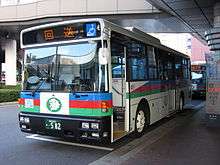Ohmi Railway
Ohmi Railway Co., Ltd. (近江鉄道株式会社, Ōmi Tetsudō Kabushiki-gaisha) is a Japanese private railway company which operates in Shiga Prefecture, and a member of the Seibu group since 1943. The company is named after the Ōmi Province, the former name of the present-day Shiga. The railway is nicknamed "Gachakon train" (ガチャコン電車, Gachakon densha) by local users because of its noisy sound.[1]


History
Ohmi Railway is the longest private railway company in Shiga. The company was founded in 1896 and started train services from Hikone to Echigawa in 1898. The company was a subsidiary of Ujigawa Electric (宇治川電気, Ujigawa Denki) from 1926 to 1942. In 1944, the company absorbed the Yōkaichi Railway (八日市鉄道, Yōkaichi Tetsudō), now the Yokaichi Line.
Lines
Ohmi Railway consists of three lines: the Main Line, and two branch lines, the Yōkaichi Line and the Taga Line.
The Main Line connects with the Tōkaidō Main Line (Biwako Line), the Hokuriku Main Line and the Tōkaidō Shinkansen at Maibara, the Biwako Line at Hikone, and the Kusatsu Line and the Shigaraki Kōgen Railway at Kibukawa. The Yōkaichi Line connects with the Biwako Line at Ōmi-Hachiman.
| Line | Section | Length (km)[2] | Stations[2] | Date opened[3] |
|---|---|---|---|---|
| Main Line | Maibara - Kibukawa | 47.7 | 25 | June 11, 1898 |
| Yōkaichi Line | Yōkaichi - Ōmi-Hachiman | 9.3 | 6 | December 29, 1913 |
| Taga Line | Takamiya - Taga Taisha-mae | 2.5 | 3 | March 8, 1914 |
| Total | 59.5 | 34 |
At first, the Main Line was planned to connect Hikone and Fukawa (now Kōnan) and run through to Ujiyamada. The Yōkaichi Line had a 2.8 km branch line from Shin-Yōkaichi to Misono between 1930 and 1964.[3]
Other services
The company also operates bus lines,[4] taxis,[5] Hachimanyama Ropeway,[6] Shizugatake Lift,[7] ships of Lake Biwa,[8] a tour operator,[9] an onsen hotel,[10] two expressway service areas,[11][12] a campsite,[13] a driving school[14] and parks[15] in Shiga.
References
- Masatoki, Minami (2009-06-19). ガチャコン電車で琵琶湖への旅 滋賀県・米原 - 近江八幡間 [Trip to Lake Biwa with Gachakon train between Maibara and Ōmi-Hachiman, Shiga] (in Japanese). Nikkei Business Publications. Archived from the original on 2011-07-19. Retrieved 2010-10-26.
- Ohmi Railway Corporation. 会社概要-近江鉄道グループ (in Japanese). Archived from the original on 2010-12-29. Retrieved 2010-10-26.
- Keisuke Imao, ed. (2008-12-18). 日本鉄道旅行地図帳 8号関西1 [Railway Atlas of Japan 8 Kansai 1] (in Japanese). Shinchosha. pp. 43–44. ISBN 978-4-10-790026-5.
- Ohmi Railway Corporation. 近江鉄道バス・湖国バス (in Japanese). Retrieved 2015-09-12.
- Ohmi Railway Corporation. 近江タクシー (in Japanese). Retrieved 2010-10-26.
- Ohmi Railway Corporation. 八幡山ロープウェー (in Japanese). Retrieved 2010-10-26.
- Ohmi Railway Corporation. 賤ケ岳リフト (in Japanese). Retrieved 2010-10-26.
- Ohmi Railway Corporation. 琵琶湖観光船 オーミマリン (in Japanese). Retrieved 2010-10-26.
- Ohmi Railway Corporation. オーミグリーンツアー (近江トラベル株式会社) (in Japanese). Retrieved 2010-10-26.
- Ohmi Railway Corporation. 国民宿舎かもしか荘 (かもしか温泉) (in Japanese). Archived from the original on 2010-11-20. Retrieved 2010-10-26.
- Ohmi Railway Corporation. 賤ヶ岳サービスエリア (下り線) (in Japanese). Retrieved 2010-10-26.
- Ohmi Railway Corporation. 新名神高速道路 土山サービスエリア (in Japanese). Retrieved 2010-10-26.
- Ohmi Railway Corporation. 鈴鹿キャンプ場 (in Japanese). Archived from the original on 2010-05-04. Retrieved 2010-10-26.
- Ohmi Railway Corporation. まの自動車教習所 (in Japanese). Retrieved 2010-10-26.
- Ohmi Railway Corporation. 近江鉄道ゆうグループ (in Japanese). Archived from the original on 2010-10-08. Retrieved 2010-10-26.
External links
| Wikimedia Commons has media related to Ohmi Railway. |
- Ohmi Railway Group (in Japanese)
- Ohmitetudo channel - YouTube